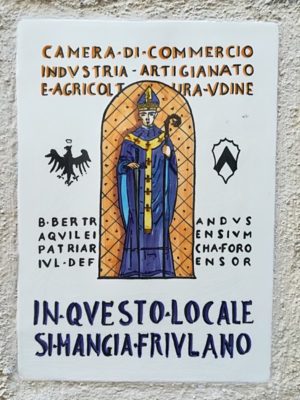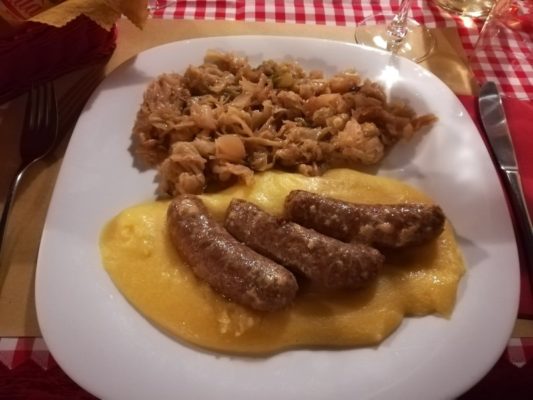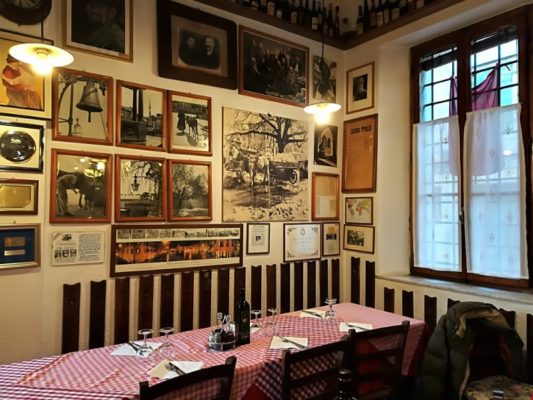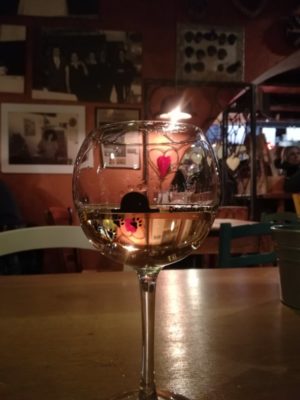In Friulian culture, local restaurants (here known as osterie) have always played a significant role on a social and cultural level.
In the past, they were true inns that provided food and rest to travelers. Later, in the 1960s and 1970s, they evolved into places of social gathering.

Plaque placed at the entrance of “Al Vecchio Stallo” local restaurant
People from neighborhoods and villages would come together to discuss what was happening in their communities, to talk about politics and sports.
During the afternoons, it was customary to play cards, mostly games like briscola, tressette, scala 40 and on special occasions, morra as well.
In front of the osterie, political rallies were also held during election campaigns, and I remember them well too.

A good glass of wine at “Ai Barnabiti” local restaurant
However, these were also places with economic and commercial significance.
Inside the taverns, various business deals were concluded, such as the buying and selling of livestock, and negotiations for the purchase of real estate and agricultural products took place.
Today, people gather to enjoy moments of relaxation and leisure with friends and acquaintances, simply for the pleasure of being in good company.
The busiest times are typically in the morning and late afternoon, when people leave their workplaces.

Tables outside “Al Cappello” local restaurant
If you find yourself in Udine for study, work, or tourism and have a desire to eat and drink well, here I’m going to suggest you my favourite local restaurants.
Some of them may not have many seats available, so I recommend making a reservation in advance.
Oh, I almost forgot to tell you that if you want to enjoy a good glass of wine and order it the way we do, remember that in the Friulian language, a glass of wine is called “taj di vin”.

Sign placed on the entrance door of “Al Marinaio” osteria: “Those on a diet should stay outside”
Table of Contents
Best Restaurants in Udine
Osteria Al Marinaio
It’s definitely one of the places where I always stop to eat happily because I can savor my favorite dishes from traditional cuisine.
Just the way my grandmother used to prepare them.

The menu hanging on the wall of “Al Marinaio” osteria
It’s an informal, down-to-earth place with rustic decor and wooden beams on the ceiling.
Beautiful vintage urban art photos adorn the walls, and the menu of the day is written on blackboards with white chalk.
The portions are generous, and I can never resist the salame with vinegar and polenta, the sausage with savoy cabbage, and the “toc’ in braide”.
The latter is a typical dish of Friulian cuisine, consisting of a bed of soft polenta topped with a cheese fondue.
If you’re looking for just an aperitif, on sunny days you can sit at the outdoor tables under the portico or in front of the bar counter.

A plate of sausage with savoy cabbage and polenta at “Al Marinaio” osteria
Things to See Nearby
Borgo Grazzano is certainly one of the city’s oldest neighborhoods.
Just think, as far back as 1030, there was a chapel dedicated to the worship of Saint George, owned by the Hospitaller Knights of Saint John.
The main street, Via Grazzano, hosts several intriguing tourist attractions.
For instance, in the house at the corner of Piazza Garibaldi, the painter Giovanni da Udine was born in 1487. He became a significant figure in figurative culture in Rome during the 16th century.

The building that houses the Friuli Ethnographic Museum
A little further down the road, Palazzo Giacomelli has been hosting the Friuli Ethnographic Museum since 2010.
The interpretive space features an exhibition divided into various aspects of local culture, spanning from the 18th to the 20th century.
The Church of San Giorgio, located about halfway down the street, was built in the second half of the 18th century. Behind the religious building stands the theater of the same name.
In the past, Via Grazzano was intersected by a small canal, which was then buried in the 1950s.
Today, two short segments have been restored and uncovered, one in front of the Ethnographic Museum and the other right across from Osteria Al Marinaio.
Osteria Al Vecchio Stallo
It’s one of the historic establishments in the city. Located in a 17th-century building (Palazzo Magrini), it used to be a gathering place for merchants, travelers, and knights.
Back then, the establishment included an inn, a stable to house horses, and an arcade where carts could be parked.

The exterior of “Al Vecchio Stallo” local restaurant
Hence the name “Vecchio Stallo,” which translates to “Old Stopover”.
I started frequenting this osteria in the mid-1980s when I was working for a construction company located nearby.
It’s a place with a warm, genuine atmosphere, to the extent that it feels like being among friends. The tables have the classic checkered tablecloths in white and red squares.

A corner of the dining room at “Al Vecchio Stallo” local restaurant
On the walls, there are photos and antique items that evoke the past: bridles, packsaddles, saddles, aluminum containers used for milk transportation, and old radios.
The menu is based on traditional dishes like homemade gnocchi, brovada and musetto, frico, cod with polenta, mixed boiled meat, pork shank, and cjarsons.
Cjarsons are a kind of typical stuffed ravioli from Carnia, but they are also popular in the Friulian plain.

A typical dish at “Al Vecchio Stallo,” sausage with mashed potatoes
Things to See Nearby
A few tens of meters from “Vecchio Stallo,” in Piazzale XXVI Luglio, stands the Ossuary Temple for the Fallen of Italy, with its distinctive turquoise-colored dome.
The design for the current building, a collaboration between architects Provino Valle from Udine and Alessandro Limongelli, was approved in 1932.
Construction was completed in 1940, the year of its consecration. The interior houses the remains of over 21,000 soldiers who fell during World War I in Friuli-Venezia Giulia.

The Ossuary Temple in Piazzale XXVI Luglio
Next to the religious building is Parco Moretti. In the past, the famous Brewery and the old stadium of Udinese football club stood in this area.
Osteria Al Cappello
Since the 1980s, when I attended an evening English school, it has always been one of my go-to places when I want to enjoy a good glass of wine.
Over the years, it has become one of the trendiest spots in the city and is very popular among a young clientele.

The hats hanging from the ceiling of “Al Cappello” osteria
The venue is located on the ground floor of a 16th-century building and is just a stone’s throw away from one of Udine’s most iconic places, Piazza Giacomo Matteotti (known locally as Piazza San Giacomo or Piazza delle Erbe).
The walls feature photos that recall the history of the establishment, and on the ceiling, numerous hats of various shapes and materials are hung.
On sunny days, you can also sit at the outdoor tables.

A glass of Sauvignon wine at “Al Cappello” osteria
As I mentioned in the article where I recommend where to stay in Udine, on the upper floors of the building, you’ll find the rooms of the eponymous inn.
Things to See Nearby
Right in front of the osteria, there’s the Art Nouveau building that once housed the city’s Fish Market.
Since 2009, the building has been home to the permanent art gallery named after the famous Udinese photographer and artist, Tina Modotti.

The building that once housed the old Fish Market of Udine, now the Tina Modotti Gallery
Osteria La Ciacarade
“La Ciacarade” osteria (meaning “the chat” in Friulian) is located on the ground floor of a building that previously housed some regional offices.
It’s a reliable choice for those who want to eat well in Udine.

Emanuele Alabò, the owner of “La Ciacarade” osteria
Even though the menu offers some traditional dishes (the mixed boiled meat, for example, is delicious), Emanuele Alabò has focused on refined and quality dishes, based on the seasonality of ingredients.
Throughout the year, the menu features theme days (such as a meat barbecue, mixed fried fish, mixed boiled meat) and during the summer, you can dine outdoors in the garden located at the back of the establishment.

Pljeskavica with vegetable sataras at “La Ciacarade” osteria
Things to See Nearby
Just a few steps from the establishment, at the corner of Piazza del Duomo, stands the Oratory of the Purità. It was built in 1757 on the site where the Mantica family’s theater previously stood.
One of Giambattista Tiepolo’s masterpieces, the famous Assumption fresco, adorns the ceiling. Inside the church, there are also other works by the Venetian painter and his son, Giandomenico.

The facade of the Cathedral of Santa Maria Annunziata
In front of the oratory stands the Cathedral of Santa Maria Annunziata. The construction work on the cathedral began in 1236 by order of Patriarch Bertoldo of Andechs-Merania.
The earthquake of 1348 caused significant damage to the building, which was subsequently repaired in the decades that followed through numerous reconstruction and restoration efforts.
Next to the Cathedral stands the bell tower, and inside it (at the base) is the Cathedral Museum.
The museum is mostly dedicated to the figure of Blessed Bertrando of San Genesio, and I highly recommend visiting it as it’s quite interesting.
Osteria Al Canarino
It’s the classic Friulian local restaurant, and its history has distant origins.
Born as a place for rest and refreshment in the early 19th century, it was known as “Croce Rossa” until 1883 because there was a military infirmary nearby.

The entrance of “Al Canarino” local restaurant
Since 1967, it has been run by the family of the current owner, Andrea Boel. All the furnishings are antique, and the tables date back to the early 20th century.
Customers come here for a simple aperitif or to have lunch and dinner.
In addition to filled sandwiches and various snacks, you can savor typical local dishes like frico, brovada with musetto (cotechino), and barley and beans, which are truly delicious.

Cod with polenta, one of the specialties at “Al Canarino” osteria
Before dinner, the place fills up with people, and it has become a well-established tradition. Many patrons take seats on the stools outside on the sidewalk.
I also started going to Il Canarino in the mid-1980s. I often found craftsmen from my hometown who came to work in Udine for lunch.
Osteria Ai Barnabiti
The “Ai Barnabiti” osteria is located in Piazza Garibaldi, right at the corner of Via Cussignacco.

“Ai Barnabiti” local restaurant entrance
When I was young, the space currently occupied by the establishment was divided between a commercial activity and a small bar.
The osteria was opened in 1998, and in my opinion, it’s an ideal place to stop for an aperitif in good company.
Over the years, it has undergone renovations and has become an excellent wine bar. The wide selection of wines, combined with the well-stocked display of filled sandwiches and snacks, certainly invites gourmands like me to take a break.

Slices of cold cuts served with a good glass of wine at “Ai Barnabiti” osteria
The wooden furnishings evoke the typical Friulian osterie. Just above the bar counter, San Daniele hams are hanging from the wooden ceiling beams.
The menu offers excellent cold cuts and cheeses to savor, along with a variety of hot dishes that include pasta, gnocchi, and meat.
Things to See Nearby
A few dozen meters away, you can visit the Friuli Ethnographic Museum.
Now that we’ve shared with you the best restaurants in Udine, we look forward to welcoming you to our city for an aperitif together.
In the cover photo, the quote of the day: “better drunk in front of the osteria counter than sick in front of the pharmacy one”.



0 Comments